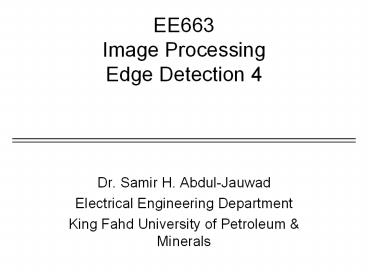EE663 Image Processing Edge Detection 4 - PowerPoint PPT Presentation
1 / 28
Title:
EE663 Image Processing Edge Detection 4
Description:
EE663 Image Processing Edge Detection 4 Dr. Samir H. Abdul-Jauwad Electrical Engineering Department King Fahd University of Petroleum & Minerals Edge Detection Edge ... – PowerPoint PPT presentation
Number of Views:195
Avg rating:3.0/5.0
Title: EE663 Image Processing Edge Detection 4
1
EE663Image ProcessingEdge Detection 4
- Dr. Samir H. Abdul-Jauwad
- Electrical Engineering Department
- King Fahd University of Petroleum Minerals
2
Edge Detection
- Non-maxima suppression
- To find the edge points, we need to find the
local maxima of the gradient magnitude. - Broad ridges must be thinned so that only the
magnitudes at the points of greatest local change
remain. - All values along the direction of the gradient
that are not peak values of a ridge are
suppressed.
3
Edge Detection
- Non-maxima suppression cont.
4
Edge Detection
- Non-maxima suppression cont.
- What are the neighbors?
- Look along gradient normal
- Quantization of normal directions
5
Edge Detection
- Canny Non-maxima suppression
gradient magnitude
thinned
6
Edge Detection
- Hysteresis thresholding / Edge linking
- The output of non-maxima suppression still
contains the local maxima created by noise. - Can we get rid of them just by using a single
threshold? - if we set a low threshold, some noisy maxima will
be accepted too. - if we set a high threshold, true maxima might be
missed (the value of true maxima will fluctuate
above and below the threshold, fragmenting the
edge).
- A more effective scheme is to use two thresholds
- a low threshold tl
- a high threshold th
- usually, th 2tl
7
Edge Detection
- Hysteresis thresholding / Edge linking cont.
- The algorithm performs edge linking as a
by-product of double-thresholding !!
8
Edge Detection
- Canny Hysteresis thresholding / Edge linking
thinned
9
Edge Detection
10
Edge Detection
11
Edge Detection Using the 2nd Derivative
- Edge points can be detected by finding the
zero-crossings of the second derivative.
- There are two operators in 2D that correspond to
the second derivative - Laplacian
- Second directional derivative
12
Edge Detection Using the 2nd Derivative
- The Laplacian
13
Edge Detection Using the 2nd Derivative
- Example
- The Laplacian can be implemented using the mask
- Example
14
Edge Detection Using the 2nd Derivative
- Properties of the Laplacian
- It is an isotropic operator.
- It is cheaper to implement (one mask only).
- It does not provide information about edge
direction. - It is more sensitive to noise (differentiates
twice).
- Find zero crossings
- Scan along each row, record an edge point at the
location of zero-crossing. - Repeat above step along each column
15
Edge Detection Using the 2nd Derivative
- How do we estimate the edge strength?
- Four cases of zero-crossings
- ,-
- ,0,-
- -,
- -,0,
- Slope of zero-crossing a, -b is ab.
- To mark an edge
- compute slope of zero-crossing
- apply a threshold to slope
16
Edge Detection Using the 2nd Derivative
- The Marr-Hildreth edge detector
- Uses the Laplacian-of-Gaussian (LOG)
- To reduce the noise effect, the image is first
smoothed with a low-pass filter. - In the case of the LOG, the low-pass filter is
chosen to be a Gaussian.
(s determines the degree of smoothing, mask size
increases with s)
17
Edge Detection Using the 2nd Derivative
- The Laplacian-of-Gaussian (LOG) cont.
- It can be shown that
18
Edge Detection Using the 2nd Derivative
- The Laplacian-of-Gaussian (LOG) cont.
19
Edge Detection Using the 2nd Derivative
- The Laplacian-of-Gaussian (LOG) cont.
20
Edge Detection Using the 2nd Derivative
- The Laplacian-of-Gaussian (LOG) cont.
21
Edge Detection Using the 2nd Derivative
- Gradient vs. LOG a comparison
- Gradient works well when the image contains sharp
intensity transitions and low noise - Zero-crossings of LOG offer better localization,
especially when the edges are not very sharp
22
Edge Detection Using the 2nd Derivative
- Separability
- Gaussian
- A 2-D Gaussian can be separated into two 1-D
Gaussians - Perform 2 convolutions with 1-D Gaussians
n2 multiplications per pixel
2n multiplications per pixel
23
Edge Detection Using the 2nd Derivative
- Separability
- Laplacian-of-Gaussian
Requires n2 multiplications per pixel
Requires 4n multiplications per pixel
24
Edge Detection Using the 2nd Derivative
- Separability
Gaussian Filtering
Image
g(x)
g(y)
Laplacian-of-Gaussian Filtering
gxx(x)
g(x)
Image
gyy(y)
g(y)
25
Edge Detection Using the 2nd Derivative
- Marr-Hildteth (LOG) Algorithm
- Compute LoG
- Use one 2D filter
- Use four 1D filters
- Find zero-crossings from each row and column
- Find slope of zero-crossings
- Apply threshold to slope and mark edges
26
Edge Detection Using the 2nd Derivative
- Disadvantage of LOG edge detection
- Does not handle corners well
27
Edge Detection Using the 2nd Derivative
- Disadvantage of LOG edge detection
- Does not handle corners well
- Why?
The derivative of the Gaussian
The Laplacian of the Gaussian
(unoriented)
28
Edge Detection Using the 2nd Derivative
- The second directional derivative
- This is the second derivative computed in the
direction of the gradient.






























